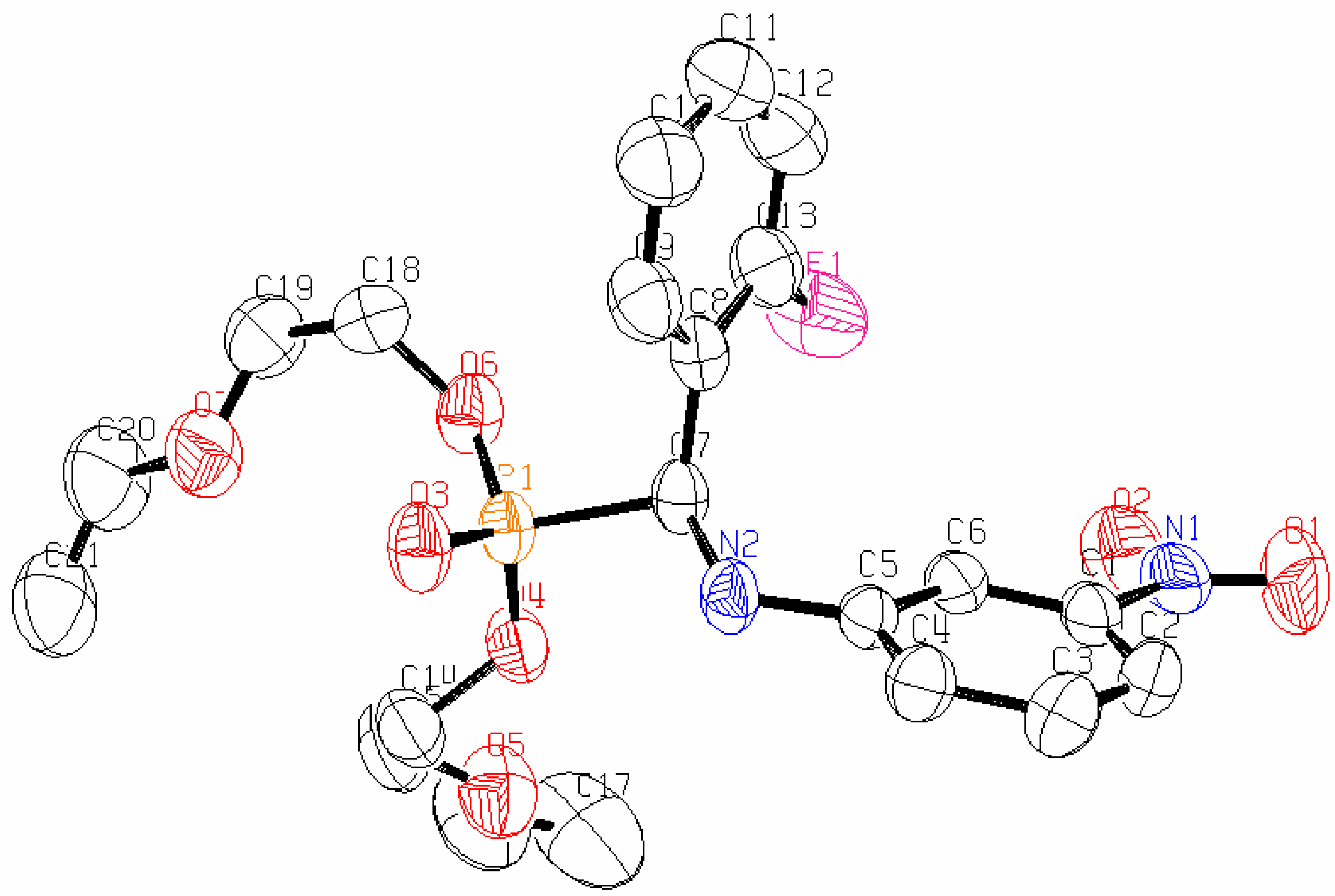Synthesis and Antiviral Bioactivities of α-Aminophosphonates Containing Alkoxyethyl Moieties
Abstract
:Introduction

Results and Discussion
| Entry | Reaction time / min | Power (W) | Reaction temperature / °C | Yield c / % |
|---|---|---|---|---|
| 1 a | 5 | 50 | 100 | 78.9 |
| 2 a | 10 | 50 | 100 | 83.5 |
| 3 a | 15 | 50 | 100 | 82.7 |
| 4 a | 20 | 50 | 100 | 81.8 |
| 5 a | 25 | 50 | 100 | 82.8 |
| 6 a | 10 | 50 | 60 | 5.0 |
| 7 a | 10 | 50 | 80 | 51.2 |
| 8 b | 10 | - | 100 | 0 |
| 9 a | 10 | 50 | 120 | 65.7 |
| 10 a | 10 | 50 | 140 | 0 |
| 11 b | 240 | - | 100 | 64.9 |
| Compd. | R1- | R2- | R3- | Yields /% b |
|---|---|---|---|---|
| 4a | 2-F | 4-CF3C6H5 | CH3 | 83.5 |
| 4b | H | 4-CF3C6H5 | CH3 | 81.3 |
| 4c | 2-F | 6-methoxybenzothiazole-2-yl | CH3 | 76.5 |
| 4d | 2-F | 3-NO2C6H5 | CH3 | 79.8 |
| 4e | 3,4,5-trimethoxy | 4-CF3C6H5 | CH3 | 70.6 |
| 4f | 4-F | 4-CF3C6H5 | CH3 | 73.6 |
| 4g | 2-CF3 | 4-CF3C6H5 | CH3 | 56.8 |
| 4h | 3-CF3 | 4-CF3C6H5 | CH3 | 79.2 |
| 4i | 3,4,5-trimethoxy | 4-CF3C6H5 | C2H5 | 78.6 |
| 4j | 2-F | 4-CF3C6H5 | C2H5 | 81.6 |
| 4k | H | 4-CF3C6H5 | C2H5 | 82.8 |
| 4l | 2-F | 3-NO2C6H5 | C2H5 | 80.5 |
Antifungal activity bioassay
Crystal Structure Analysis
Conclusions


Experimental
General
Preparation of Alkyloxyethyl-containing α-Aminophosphonates 4a-4l
Bioassays: Antifungal Bioassays
Crystal structure determination.
Acknowledgements
References
- Du, S. C.; Faiger, H.; Belakhov, V.; Timor Baasov, T. Towards the Development of Novel Antibiotics: Synthesis and Evaluation of a Mechanism-Based Inhibitor of Kdo8P Synthase. Bioorg. Med. Chem. 1999, 7, 2671–2682. [Google Scholar] [CrossRef] [PubMed]
- Zomova, A. M.; Molodykh, Zh. V.; Kudryavtseva, L. A.; Teplyakova, L. V.; Fedorov, S. B.; Ivanov, B. E. Antimicrobial activity of O,O-diethyl N-alkylaminomethylphosphonates and O-ethyl N-alkylaminomethylphosphonic acids. Pharm. Chem. J. 1986, 20, 774–777. [Google Scholar]
- Jin, L. H.; Song, B. A.; Zhang, G. P.; Xu, R. Q.; Zhang, S. M.; Gao, X. W.; Hu, D. Y.; Song Yang, S. Synthesis, X-ray crystallographic analysis, and antitumor activity of N-(benzothiazole-2-yl)-1-(fluorophenyl)-O,O-dialkyl-α-aminophosphonates. Bioorg. Med. Chem. Lett. 2006, 16, 1537–1543. [Google Scholar]
- Kukhar, V. P.; Hudson, H. R. Aminophosphonic and Aminophosphinic Acids-Chemistry and Biological Activity; John Wiley & Sons: Chichester, 2000. [Google Scholar]
- Zhang, G. P.; Song, B. A.; Xue, W.; Jin, L. H.; Hu, D. Y.; Wan, Q. Q.; Lu, P.; Yang, S.; Li, Q. Z.; Liu, G. Synthesis and Biological Activities of Novel dialkyl 1-(4-trifluoromethylphenylamino)-1-(4-trifluoromethyl or 3- fluorophenyl)methylphosphonate. J. Fluor. Chem. 2006, 127, 48–53. [Google Scholar]
- Song, B. A.; Wu, Y. L.; Yang, S.; Hu, D. Y.; He, X. Q.; Jin, L. H. Synthesis and bioactivity of 2-aminophosphonate containing fluorine. Molecules 2003, 8, 186–192. [Google Scholar] [CrossRef]
- Zideka, Z.; Kmoničkovaa, E.; Holy, A. Cytotoxicity of pivoxil esters of antiviral activity nucleoside phosphonates: adefovir dipivoxil versus adefovir. Biomed Pap Med Fac Univ Palacky Olomouc Czech Repub. 2005, 149, 315–319. [Google Scholar] [CrossRef] [PubMed] [Green Version]
- Huang, R. Q.; Wang, H. L.; Zhou, J. The Preparation of Organic Intermediates; Chemical Industrial Press: Beijing, 2001. [Google Scholar]
- Song, S. Q.; Zhou, L. G.; Li, D.; Tang, D.; Li, J. Q.; Jiang, W. B. Antifungal activity of five plants from Xinjiang. Nat. Prod. Res. Dev. 2004, 16, 157–159. [Google Scholar]
- Li, S. Z.; Wang, D. M.; Jiao, S. M. Pesticide Experiment Methods-Fungicide Sector; Agriculture Press of China: Beijing, 1991; pp. 93–94. [Google Scholar]
- Sheldrick, G. M. Program for Empirical Absorption Correction of Area Detector Data; University of Gottingen: Gottingen, Germany, 1996. [Google Scholar]
- Sheldrick, G. M. SHELXTL V5.1, Software Reference Manual; Bruker AXS, Inc.: Madison, Wisconsin, USA, 1997. [Google Scholar]
- Wilson, A. J. International Table for X-ray Crystallography; Kluwer Academic Publishers: Dordrecht, 1992; vol. C, Tables 6.1.1.4 (pp. 500-502) and 4.2.6.8 (pp. 219-222), respectively. [Google Scholar]
- Sample Availability: Samples of the compounds are available from the authors.
© 2006 by MDPI (http://www.mdpi.org). Reproduction is permitted for noncommercial purposes.
Share and Cite
Xu, Y.; Yan, K.; Song, B.; Xu, G.; Yang, S.; Xue, W.; Hu, D.; Lu, P.; Ouyang, G.; Jin, L.; et al. Synthesis and Antiviral Bioactivities of α-Aminophosphonates Containing Alkoxyethyl Moieties. Molecules 2006, 11, 666-676. https://doi.org/10.3390/11090666
Xu Y, Yan K, Song B, Xu G, Yang S, Xue W, Hu D, Lu P, Ouyang G, Jin L, et al. Synthesis and Antiviral Bioactivities of α-Aminophosphonates Containing Alkoxyethyl Moieties. Molecules. 2006; 11(9):666-676. https://doi.org/10.3390/11090666
Chicago/Turabian StyleXu, Yingshu, Kai Yan, Baoan Song, Gangfang Xu, Song Yang, Wei Xue, Deyu Hu, Ping Lu, Guiping Ouyang, Linhong Jin, and et al. 2006. "Synthesis and Antiviral Bioactivities of α-Aminophosphonates Containing Alkoxyethyl Moieties" Molecules 11, no. 9: 666-676. https://doi.org/10.3390/11090666





